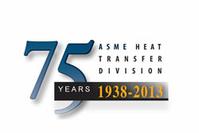Presentations at the ASME 2013 Summer Heat Transfer Conference
Presentations at the ASME 2013 Summer Heat Transfer Conference
| Event Date: | July 18, 2013 |
|---|
HT2013-17398: Impact of Phase Change on Thermal and Electrical Properties of Ionic Nanofluids
The unique properties of ionic liquids make them promising for a variety of applications from electrochemistry and “green” solvents [1] to heat transfer fluids or energy storage media in solar thermal systems [2]. Stresses during the liquid to solid phase transitions for crystal-forming fluids with graphite nanoparticles led to large shifts in thermal and electrical conductivities [3]. The large number of possible cation-anion combinations for ionic liquids yields a large range of properties and allow selection of the material melting point, crystal structure, thermal conductivity, and electrical conductivity. In this work, graphite nanoparticles are suspended in crystal-forming ionic liquids (including 1-butyl-3-methylimidazolium chloride, [bmim][Cl]) to exploit these phase-change stresses and produce large contrast between the liquid and solid properties. Thermal conductivity and thermal diffusivity are measured using the transient hot wire and laser flash techniques, while electrical impedance spectroscopy characterizes the electrical properties. Differential scanning calorimetry measures the heat capacity and phase change properties of the ionic nanofluids. Independent characterization of these properties in the liquid and solid state provides insight into the fundamental charge and heat transport mechanisms within the material.
References: 1. Tsuda, T. and C.L. Hussey, Electrochemical Applications of Room-Temperature Ionic Liquids. Electrochemical Society Interface, 2007. 16(1): p. 42-49. 2. Van Valkenburg, M.E., et al., Thermochemistry of ionic liquid heat-transfer fluids. Thermochimica Acta, 2005. 425(1–2): p. 181-188. 3. Zheng, R., et al., Reversible temperature regulation of electrical and thermal conductivity using liquid–solid phase transitions. Nature Communications, 2011. 2: p. 289.
HT2013-17517: Thermal Transport across Self-Assembled Monolayers to Water
The thermal conductance across solid-liquid interfaces is of interest to many applications, including thermal management in micro-/nano-scale electronics and biological systems. Using time-domain reflectance techniques, we measure the thermal conductance across self-assembled monolayers (SAMs), grown on gold, to water. We systematically study the thermal conductance dependence on temperature, alkane chain length, coverage area and pattern, and the effect of hydrophilic and hydrophobic heads. Throughout our studies, we will provide a comprehensive understanding of the transport mechanisms across the SAM/water interface and help tune the interfacial conductance for practical applications.
This material is based upon work supported as part of the S3TEC, an Energy Frontier Research Center funded by the U.S. Department of Energy, Office of Science, Office of Basic Energy Sciences under Award Number DE-FG02-09ER46577
Related Link: http://www.asmeconferences.org/ht2013/

